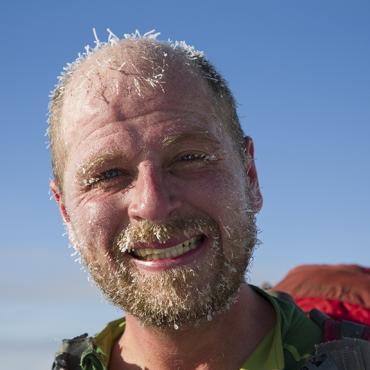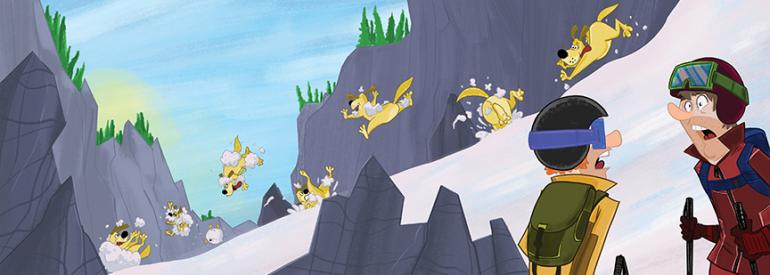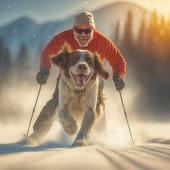True Tales: Unstable Mabel
A canine slide-for-life.
Skiing with canine comrades is one of the most rewarding experiences dog-owners can have, but it can also be one of the riskiest. The objective hazards of alpine recreation require a different interpretation when traveling with man’s best friend. Understanding these complexities is something I have learned the hard way, largely due to the events of this harrowing tale. Although my dog, the beloved Unstable Mabel, endured myriad bizarre events throughout her life, none were more stunning or gut-clenching than her 700-foot death-defying tumble at Beartooth Pass.
It was Memorial Day Weekend and I was making my first pilgrimage to the legendary locale. I was 22 years old and had some experience skiing with the pooch, but I wasn’t very backcountry savvy and didn’t give enough thought to the potential consequences of skiing with dogs in steep terrain. This was a particularly good year for snow, so there were many options for roadside ski runs, including a 300-foot, 40-degree pitch right above camp that we eagerly spun laps on before breakfast. Mabel was a 60-pound hound that had better-than-average agility and coordination for a yellow lab, but very little experience descending steep terrain or traveling on variable spring snow. However, she had no problem with the firm mid-elevation snow that morning. She chased us up and down the steep slope as we zoomed back into camp. This provided me with a false sense of confidence.
After breakfast we shuttled to the top of the pass and our motley crew of five skiers and four dogs set out under calm, clear skies to ski the Rock Creek headwall. Via a handful of different couloirs, one can ski the headwall directly down to the parking lot where the shuttle car awaits. On this particular day, there was a large peanut gallery in the parking lot that included our shuttle drivers, other skiers, and sightseeing tourists. Little did anyone know the sight they were about to see.
We chose a long, steep couloir on looker’s left of the headwall, directly west-facing and rarely filled in once the pass opens in late May. The chute started near the top of the Beartooth Plateau, so there was a flat snowfield to gear up in. Then the pitch rolled off into a 50-degree, 100-foot wide snowfield before it pinched down to about 15 feet wide with sizable granite walls on either side. At the bottom of the chute, the rock walls opened up as the chute dog-legged left, meaning the fall line led directly into a 40-degree talus field.
As we were enjoying the stunning Beartooth scenery and getting ready to drop in, BAM… just like that my buddy Matt skied down the chute and out of sight. Aaron’s dog Joe, an 80-pound boxer, gave us a funny look: “Really? You idiots want me to go down that?” Then, without waiting for his owner, Joe grunted, turned, and began to punch his way down the chute two fists at a time, pulling his hind legs forward like a frog. Seeming to have no problem with the firm, high-elevation snow conditions, Joe made his way down the chute and out of sight. One dog down, three more to go.
With my nerves—and in hindsight my ignorance—running high, I took a few turns on the steep snowfield then stopped on the side before the chute narrowed into the pinch. Travis skied down to join me—big mistake. We were now below our timid dogs and almost fully committed to the descent. Normally, Mabel would follow without question; however, something was different that day and she was hesitant to commit to the steep slope. A few minutes passed as I called to her. I knew something was off but continued to call until she reluctantly inched toward the rollover and began the descent. Cautiously crawling one foot at a time, she made it a few steps before her back legs failed to punch through the firm snow which sent her into a slide-for-life. She immediately punched her front legs through the snow but it was too late: she was airborne and into a head-over-heels tumble. By the time she careened by Travis and me, she was flipping three or four times in the air, between impacts on the snow surface. Amazingly, it appeared as though she was keeping her eyes downhill and spotting her “landings.” That gave me a glimmer of hope, but then she disappeared into the granite jaws. I raced downward thinking to myself, “I’m skiing after a dead dog.”
I watched helplessly from above as Mabel flipped and spun out of control in a straight line toward the bottom of the talus field. Seconds later—after a quadruple-flipping, double-twisting frontward aerial—Mabel miraculously self-arrested 20 feet above the rocky talus field. Finally, she’d spotted a landing that stuck.
As I closed in, she was panting heavily and staring up with a glazed look in her eye. She seemed okay with all limbs intact, but also in shock, so I picked her up and skied down a few hundred feet. At the bottom of the steep pitch she jumped out of my arms and ran to greet the other dogs near the parking lot, carrying on like nothing had happened. I was completely drained and in a bit of shock myself.
Looking back, I am appalled with myself for not realizing that I had put Mabel in a situation that could have killed her during the prime of her life. The warning signs seem so clear now. I should have hiked out the moment I realized something was off. Before that, I should have assessed the situation and skied somewhere less steep or not at all—or simply left Mabel at camp. That day, the reward was most definitely not worth the risk.
Although I took the hard route, I now have a greater respect for decision-making in an alpine environment and what it takes to keep a quadruped safe and comfortable. It took some time to regain my confidence, but Mabel and I enjoyed many more backcountry ski days together. She bravely followed and never shied away from spring ski adventures in the years after her tumble… and I have become a little less stupider.












